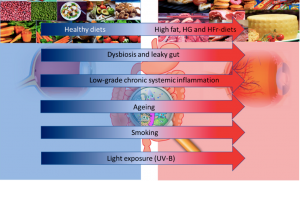According to recent studies, the health of the gut microbiome is linked to AMD.
Age-related macular degeneration (AMD) is a degenerative eye disease, of multifactorial origin, which by 2020 is estimated to affect around 198 million people worldwide.
There are two forms of AMD: the neovascular or wet form and the atrophic or dry form; While the progression of the former can be counteracted through the use of anti-VEGF (Vascular Endothelial Growth Factor) drugs, for the latter there are no therapies that can counteract its onset and progression. However, several clinical evidences attest that for the atrophic form of AMD, nutritional control is the best prevention strategy, as certain micronutrients have been shown to have the ability to reduce the risk of disease progression. Furthermore, recent studies have highlighted how a condition of intestinal dysbiosisa condition of microbial imbalance can influence the onset and progression of this serious eye disease.
Aetiopathology of AMD
The aetiology of AMD depends on several factors and although, to date, the exact causes remain unknown, experts in the field agree on the crucial role of an inflammatory state underlying AMD, together with the formation of reactive oxygen species (ROS, Radical Oxygen Species), molecules that are harmful to the body. At high concentrations, ROS, for example, can damage the retinal pigment epithelium, the layer that absorbs light and nourishes retinal cells, and increase the risk of developing AMD.
The role of the gut microbiome
Given the role of inflammation and free radicals underlying the onset of AMD, it was hypothesised that some nutrients with anti-inflammatory and antioxidant action, directly or indirectly, via the gut microbiome may have beneficial effects in preventing AMD. This hypothesis has aroused a lot of interest from the scientific community, which has started to investigate the effectiveness of prebiotics and probiotics as well as antioxidant-rich foods as a prevention strategy for AMD.
The gut microbiome consists of a pool very large number of microorganisms, diverse in microbial species, which is indispensable for the well-being of our organism. With the normal ageing process and especially from the age of 65, the age at which AMD most frequently appears, the intestinal microbiome undergoes changes by losing, for instance, its enormous microbial diversity. These changes are reflected in a different immune response and appear to be linked to the onset of various metabolic diseases such as diabetes or age-related diseases such as AMD.
Which micronutrients are useful in the prevention of AMD and why
A very recent review all-Italian, published in the magazine Nutrients, collecting some of the most significant studies that had analysed the role of the gut microbiome on AMD, highlighted how the eating habits are closely associated with certain diseases. A 'Western' diet based on high consumption of dairy products, red meat, sweets and energy drinks is predominantly associated with individuals with AMD; An 'oriental' diet, on the other hand, based on the intake of legumes, rice and low-fat dairy products has been shown to have a preventive role in the onset of this eye disease. The elements with major beneficial effects on ocular health are listed below:
by Rinninella E. et al. 2018
Vitamin C and E
Vitamin C and Vitamin E are among the most powerful antioxidants. The former is present in high concentrations in various ocular compartments such as the cornea, corneal epithelium and tear film; the latter is part of a large group of fat-soluble molecules and is able to reduce free radicals and inhibit the diffusion of ROS.
Zinc
Zinc is a trace element indispensable for the construction of DNA and for the correct formation of certain proteins. It is present in various ocular structures such as the retina and choroid. Studies have shown that a zinc deficiency predisposes to poor night vision. Furthermore, a clinical study showed that taking at least 80mg of zinc in combination with other antioxidants reduces the progression of AMD in more advanced forms.
Carotenoids
Carotenoids are molecules found in many fruits and vegetables and Beta-carotene supplementation, for example, is effective in preventing AMD and other eye diseases. This, together with lycopene, also protects the choroid from damage due to oxidative stress.
Lutein and Zeaxanthin
Also belonging to the class of carotenoids are lutein and zeaxanthin, molecules that accumulate in the retina and play a key role in maintaining the correct structure and function of the macula, the central part of the retina.
These molecules are readily available through the intake of vegetables such as spinach, lettuce or broccoli, or through the intake of animal fats found, for instance, in eggs.
In case of deficiencies due to pathological conditions or inadequate nutrition, lutein and zeaxanthine can be supplemented with specially formulated nutraceuticals.
Sources:
-Rinninella E. et al. The Role of Diet, Micronutrients and the Gut Microbiota in Age-Related Macular Degeneration: New Perspectives from the Gut-Retina Axis. Nutrients 2018, 10, 1677
–https://www.thelancet.com/journals/langlo/article/PIIS2214-109X(13)70145-1/fulltext
Dr. Carmelo Chines
Direttore responsabile

